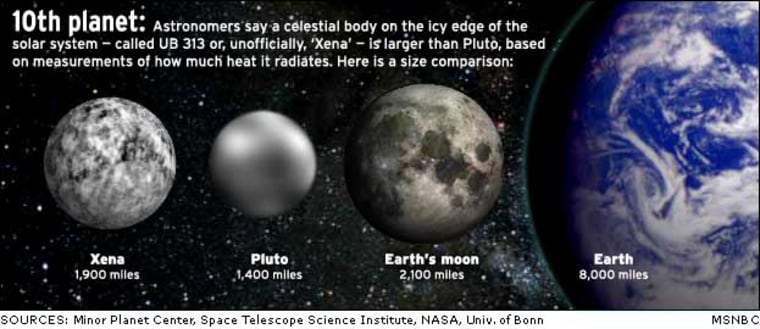An object discovered earlier this year and considered by some to be our solar system’s 10th planet is indeed larger than Pluto, a new study confirms.
The object, cataloged as 2003 UB313, is by many accounts a planet. It is round and orbits the sun.
But because several other objects meet those criteria and also approach Pluto’s size, astronomers have been wrangling for months over how to define the word “planet.” It is not known if or when the International Astronomical Union, which rules on such things, will issue a decision. Members of an advisory board weighing the issue can’t even agree on the parameters of a definition.
Meanwhile, 2003 UB313 is now known to be about 1,860 miles (3,000 kilometers) in diameter, give or take 190 miles (300 kilometers).
Pluto is 1,430 miles (2,300 kilometers) wide.
The object’s size was initially calculated based on an estimate of how much sunlight it reflects. But astronomers don’t know exactly what its surface is made of, so they could not be sure how reflective it is.
The new study, led by Frank Bertoldi from the University of Bonn, relies on new observations of 2003 UB313’s thermal emission. The calculations are based on the object’s size and its surface temperature, which can be estimated based on the object’s distance from the sun.
The results are detailed in Thursday's issue of the journal Nature.
"Since UB313 is decidedly larger than Pluto," Bertoldi said, "it is now increasingly hard to justify calling Pluto a planet if UB313 is not also given this status."
But 2003 UB313 is much farther away. Its elongated orbit takes it far out into the icy Kuiper Belt, twice as far from the sun as Pluto. Many astronomers now say Pluto is a Kuiper Belt Object and should never have been called a planet.
So if 2003 UB313 is termed a planet, as some suggest, then a handful of other good-sized, round worlds known to exist — and perhaps hundreds yet to be found in the Kuiper Belt — would also have to be called planets. Among the other candidates: Sedna, which is about three-fourths as large as Pluto, 2004 DW and Quaoar.
One suggestion is to call the outer worlds “dwarf planets.”
Scott Sheppard of the Carnegie Institute of Washington takes this view:
“Whichever way you care to count them, with the discovery and measurement of the size of 2003 UB313 there are no longer nine major planets in the solar system,” Sheppard writes in an analysis for Nature.
Sheppard also notes a surprise that’s come from this study and others recently.
Astronomers have now accurately measured the diameter and reflectiveness, or albedo, of a handful of Kuiper Belt Objects.
“It seems that the largest objects have the highest albedos,” Sheppard said. “This could be because gravity on these objects is large enough for them to have active atmospheres and so be able to retain volatile gaseous substances that could brighten their surfaces.”
